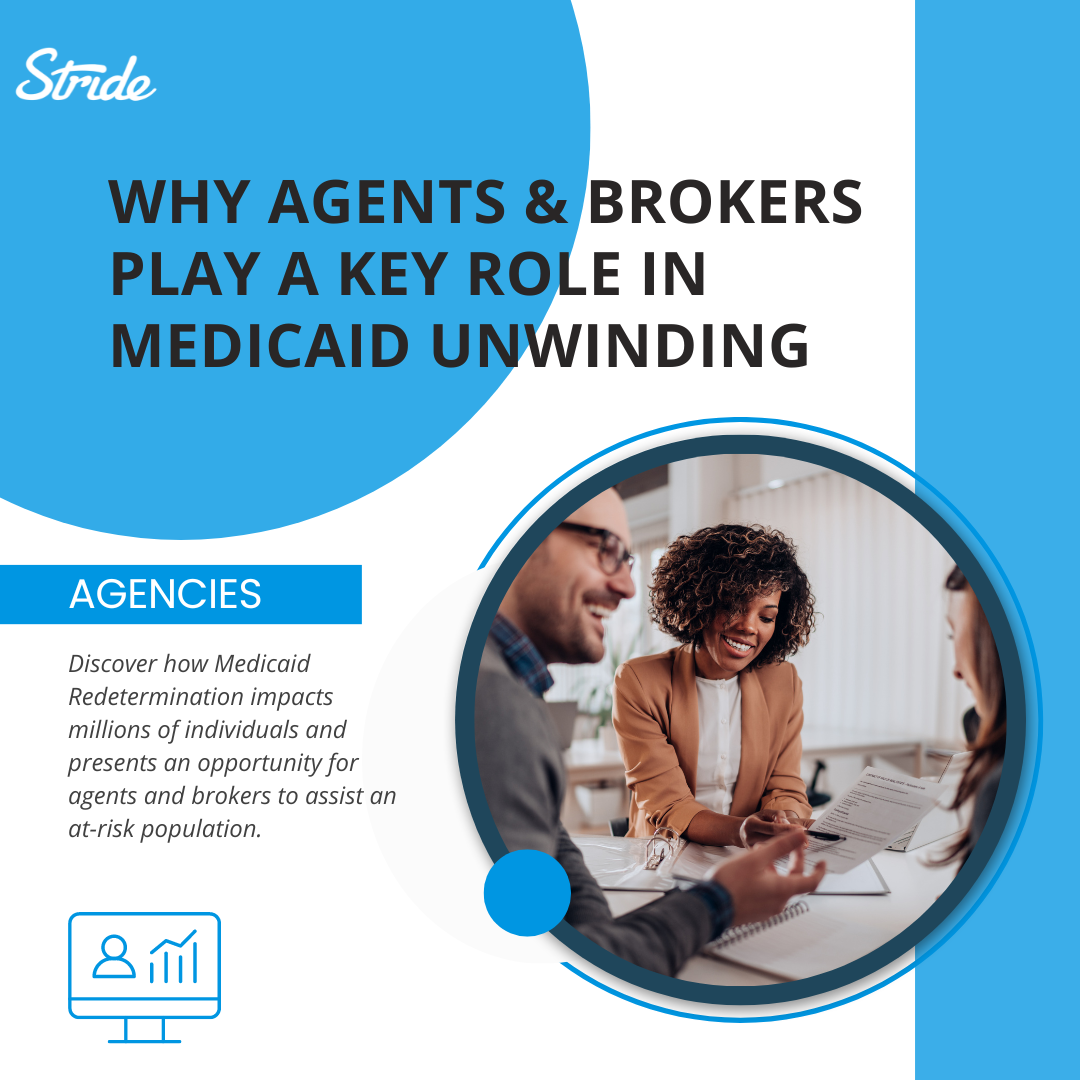Medicaid isn’t a segment of the healthcare ecosystem that health insurance agents and brokers traditionally work within. Medicaid beneficiaries can seem like an entirely separate group carved out from your typical client business, and it makes sense why. Specific rules and regulations, state-specific programs, and restrictions on direct enrollments mean you literally can’t work with these individuals. And so, there’s no real incentive to keep track of what’s going on in that space.

Subscribe to the Blog
Stay up to date

Bryan Giaimo
General Manager, Enterprise Partnerships & Solutions
Medicaid isn’t a segment of the healthcare ecosystem that health insurance agents and brokers traditionally work within. Medicaid beneficiaries can seem like an entirely separate group carved out from your typical client business, and it makes sense why. Specific rules and regulations, state-specific programs, and restrictions on direct enrollments mean you literally can’t work with these individuals. And so, there’s no real incentive to keep track of what’s going on in that space.
That is, until now. Medicaid Redetermination, also known as unwinding, officially resumed on April 1, 2023, after redeterminations had been paused over the past three years due to the COVID-19 public health emergency. Overall, Medicaid coverage has extended to a wider reach of individuals partly as a reflection of economic conditions related to the pandemic as well as the adoption of Medicaid expansion in some states as part of the Affordable Care Act. But primarily, Medicaid enrollment has increased since the start of the pandemic due to the continuous coverage provision, meaning that everyone who was covered by Medicaid could stay covered without having to take any action.
Now, eligibility verification is resuming as states work through millions of redetermination decisions. It presents a massive undertaking for states and could result in loss of coverage for up to 18 million individuals, whether due to ineligibility or administrative attrition.
Unwinding is expected to cause major disruption. It’s predicted 4.8 million people will either simply become uninsured or turn to the non-group market. But with outreach, connection, education, and guidance, any gaps in coverage this at-risk population might experience could be limited.
That’s where agents and brokers come in, as you are a key part of connecting individuals to coverage. So, while you may not have worked with Medicaid beneficiaries in the past, unwinding presents an opportunity to help an at-risk population while becoming the trusted advisor to a new group in need of individual or family coverage.
As often is the case when reaching out to a new audience, it’s hard to know the best ways to reach them, much less engage. Here are three tips for building new client relationships proactively and successfully:
1.
Start with education.
Some of the individuals affected by redetermination may feel overwhelmed, not understanding their coverage options, assuming they can’t afford it, or not realizing they may qualify for Advance Premium Tax Credits (APTCs).
With premium tax credit eligibility available to more Americans, coverage is more affordable for a broader range of people, making it easier to attract those who’ve been chronically uninsured and may not have explored individual or family coverage before now.
Those two factors make it important to lead with education, making you the trusted advisor while building relationships and gaining new clients.
2.
Bolster your distribution lists and other outreach opportunities.
For agencies, marketing to your email list is a primary way to promote services. So, we suggest creating an email marketing approach that communicates specifically how your agency can assist those impacted, identifying the most appropriate contacts to send your emails to rather than a general blast. Additionally, you can get creative in your marketing approach by capturing new contacts through social media and digital advertising, encouraging people to stay up to date on the latest by signing up for emails and newsletters from your agency.
Of course, outreach extends beyond the inbox. Some communities rely more heavily on different communication channels than others, which is why it’s important to consider cultural relevance when determining how and where to conduct outreach. For example, Vietnamese and some Spanish-speaking populations rely more heavily on radio. Placing ads in that medium and using primary language can go far in reaching a population that might not have had as much access to information otherwise.
3.
Think outside the box for engagement opportunities.
Sometimes you have opportunities for engagement sitting right within your existing book of business. For example, agents and brokers may have previously assisted mixed coverage households where one member of the household may have an Individual & Family plan while another is covered under Medicaid. Using that information, you can review your book of business to identify any of those individuals who previously qualified for Medicaid to see if they need assistance in the event they lose coverage.
Engagement can also come in the form of partnerships. Health plans have likely had more contact with beneficiaries than even the state has had during the past few years. At the very least, they are also taking concrete steps to reach these individuals coming off Medicaid. Partnering with health plans and sharing what each of you is doing can result in a win-win for everyone, especially the at-risk individuals, in the end.
Efficiency, security, and growth with Stride
Ultimately, it’s going to take all stakeholders in the healthcare ecosystem to help these individuals. Agents and brokers like you play an important role. You can help millions of Americans affected by Medicaid Redetermination find and enroll in new health coverage. Stride is here to help.
Stride’s Enhanced Direct Enrollment Phase 3 platform offers agents and brokers an end-to-end solution for your ACA book of business. With a complete view of your business through our comprehensive broker dashboard, you can manage growth efficiently. Plus, your leads remain exclusively yours with our data separation and protection capabilities.
As you think about your Agency's growth, consider how a partner like Stride could help empower that growth – no matter what changes happen in healthcare. Are you ready to learn more? Connect with me on LinkedIn, send me an email, or request a demo today.
About Stride
Stride is a San Francisco-based company offering a SaaS insurance recommendation and enrollment platform that simplifies the purchasing process for health plans, agencies, and consumers. Our end-to-end solution offers flexible tools for shopping, enrollment, and post-enrollment management plus proprietary decision support tools. Stride is among a select few companies to offer Phase 3 Direct Enrollment (EDE) integration. To learn more, visit stridebenefits.com.
Why Agents & Brokers Play a Key Role in Medicaid Unwinding
Medicaid isn’t a segment of the healthcare ecosystem that health insurance agents and brokers traditionally work within. Medicaid beneficiaries can seem like an entirely separate group carved out from your typical client business, and it makes sense why. Specific rules and regulations, state-specific programs, and restrictions on direct enrollments mean you literally can’t work with these individuals. And so, there’s no real incentive to keep track of what’s going on in that space.
05/19/2023

Subscribe to the Blog
Stay up to date

Written by Bryan Giaimo
There are no related posts
Final CTA
Lorem ipsum dolor sit amet, consectetur adipiscing elit, sed do eiusmod tempor incididunt ut labore et dolore magna aliqua. Ut enim ad minim veniam, quis nostrud exercitation ullamco laboris nisi ut aliquip ex ea commodo consequat.

